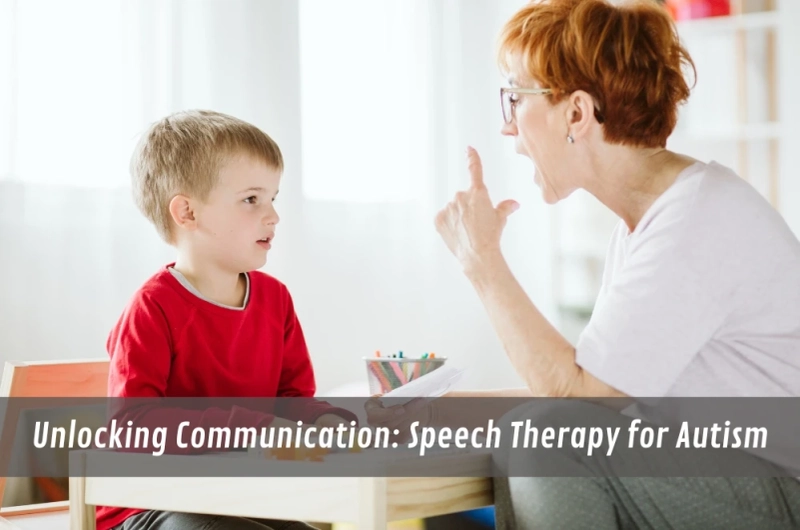Imagine a world where words feel like a puzzle, where expressing needs and understanding others is a daily struggle. This is the reality for many children with autism spectrum disorder (ASD). Communication difficulties are a hallmark of autism, impacting social interaction, learning, and overall well-being. On a brighter end, something so working as speech therapy for autism in Sydney can make things work differently by developing one's communication ability to understand oneself and connect the world with everything. Here lies the research within the vital work of speech therapy for an autistic individual.
Autism and communication: Communication challenges
For individuals with autism, communication can be impacted in different ways. Some are nonverbal and will make sounds but not communicate verbally. Others have an excellent vocabulary but cannot complete the social aspects of a conversation. Some challenges include:
- Late language development: Children with autism might speak later than other children or have a minimal vocabulary.
- Trouble with social interactions: Understanding nonverbal messages, such as facial expressions or body language, may be challenging. Initiating and sustaining conversation can also be tricky.
- Echolalia: Saying words or phrases he/she heard, often in a non-meaningful way.
- Trouble with pragmatics: This includes the rules of interaction in language, like who speaks at what turn in a conversation or how to vary one's communication according to the situation.
- Abstract language: Figurative language, idioms, and sarcasm can be confusing.
These communication challenges can lead to frustration, social isolation, and difficulties in school or social settings. However, with appropriate support, therapy, and communication strategies, individuals with autism can develop effective ways to express themselves and engage meaningfully with others. While this article focuses on speech therapy for autism, speech and language pathologists also help individuals with other communication difficulties, such as stuttering and fluency disorders.
Early speech therapy intervention
Early intervention is highly recommended to develop communication in autistic children. Since the brain learns best in the early years, it is always the best period to establish some foundational communication. Early speech therapy can:
- Improve receptive language: This means children can understand the other person
- Improve expressive language: For example, questioning and asking for something they want or need
- Social communication skills: Teach children to take turns, follow eye contact, and pick up on social cues.
- General development: Communication skills have a positive connotation for the other aspects of development, such as social skills and behaviour.
Early speech therapy for a child suffering from autism can be the single best opportunity throughout his lifetime to reach his maximum potential.
Types of speech therapy for autism
Individualised speech therapy is tailored according to the individual to meet and address his strengths and communication goals. A speech-language pathologist assesses his strengths and challenges and develops a treatment plan. Some approaches that people go for are as follows:
- Applied behaviour analysis (ABA): A program that reinforces targeted skills in individuals through positive reinforcement and repetition.
- Picture exchange communication system (PECS): This means communicating wants and needs through pictures.
- Social skills training would involve instruction and applying social communication skills in a safe, supportive environment.
- Augmentative and alternative communication (AAC): This could involve a speech-generating device or an app that augments the child's communication.
- Play-based therapy: Involving the child in a playful activity that helps prompt speech.
The SLP may use a combination of these approaches, depending on the individual's needs and preferences. While speech therapy focuses on communication skills, early intervention programs for autism often take a more holistic approach, addressing social, behavioural, and other developmental needs.
Strategies for speech therapy sessions
These practical speech therapy sessions involve different techniques to stimulate the person and result in learning, such as:
- Using visual supports: Such as pictures, symbols, or written-word support to understand.
- Modelling the skills: One needs to convey the skills to the individual.
- Role-playing: of social communication skills while acting out different scenarios.
- Positive reinforcement: Helps build motivation and learning through praise and encouragement.
- Repetition: Words or phrases to make it easier to remember and understand.
- Individualised activities: Based on the interest and ability of an individual.
Parents and care providers can also engage with the speech-language pathologist to implement the same goals in one's life for application at home. The speech-language pathologist can give ways and recommended activities for daily habits and other spheres of life.
Advantages of speech therapy to an individual with autism
Speech therapy can have an impact on individual lives with Autism. Such influences may include:
- Improved communication skills: Enhance ability to meet needs, wants, and ideas.
- Increased socialisation: Increased ability to connect and associate with people.
- Increased autonomy: Effective communication results in an individual's better capacity to care for himself/herself.
- Less frustration: It reduces frustration and challenging behaviour that may emerge during communication failure.
- Better performance: Good communication increases the opportunities to learn, become involved, and participate more successfully in school.
- Increased sense of self: Positive communication enhances the individuals' autonomy, self-esteem, and control.
Speech therapy is unique for everyone. What works for one may not work for another. The clue to this lies in choosing the right therapist with the appropriate combination.
Conclusion
When seen as a human right, communication opens the door to benefits that unlock the personality and world of the majority of people with autism. However, all such barriers can be overcome with early intervention, individualised therapy, and support throughout life. Speech therapy can, therefore, let autistic individuals share the world of existence around them with other individuals, articulate their emotions, and live their lives to their potential by letting out their feelings while building their speech skills. While summer blossoms life in the otherwise inert parts of Sydney's life, appropriate communication infuses life into a relationship with an individual having an autism problem. Suppose one is concerned about how a child communicates. In that case, it is always important to seek first the advice of an expertly qualified speech-language pathologist, as communication plays a crucial role in child learning and development.


